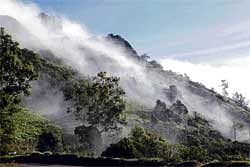A bright shade of green

Chikmagalur is a district blessed with velveted green hills, waterfalls and a lot of history. There are many interesting stories behind how Chikmagalur got its name.
While the popular story, the one in most circulation, is that the town got its name because it was the town of King Rukmangada’s younger daughter, there are other stories. Historians point out that Chikmagalur derives its name from the word Kiriya Mugali, while Hiremagalur derives its name from Hiriya Mugali.
While Kiriya and Hiriya indicate smaller and higher respectively, Mugali is the name of a local plant. It is said that with the passage of time, the kiriya in Kiriya Mugali, got replaced with Chikka a synonym for smaller. Mugali became Magala (which means ‘of the daughter’ in Kannada). This has even been brought to light in some inscriptions.
Chikmagalur has a history dating back to the Stone Age period. The stone implements found in the hills near Kadur, Nidaghatta, Lingadahalli and Tarikere point to the earliest human settlements dating back to the Stone Age here.
Stone inscriptions point out that the region was ruled at different points in time by the Nandas, Mauryas, Shatavahanas and Pallavas. Historians point out that the Kadambas also ruled the region. The first Kannada inscription to have been found, the Halmidi inscription, was unearthed at Halmidi, a village near Chikmagalur. Later, the Gangas of Talakad are said to have conquered parts of the Chikmagalur region.
Most importantly, what needs to be emphasised here is that the birth of the Hoysala dynasty was in the Chikmagalur region. It is said that the founder of the dynasty, Sala, was born at Shashakapura, now known as Angadi.
After the fall of the Hoysala kingdom, the Vijayanagar kings took over the reign of the region. A major part of the district was ruled by the Keladi dynasty after the Battle of Talikota. It was much later, after the fall of the Keladi dynasty (1694), that Chikmagalur became part of the Mysore kingdom. The Mysore kings had a special place in their hearts for Chikmagalur district. They took up several development projects in the region, and made their own contribution to the growth of the district.
Kadur district, carved out in 1863
A separate Kadur district was carved out in 1863. Kadur, Yagati, Garudanagiri and Banavar taluks were part of the district. It was in 1865 that the Vastare taluk was formed. In 1876, the Moodigere taluk was formed. Manjarabad, Belur and Vastare became part of Moodigere taluk.
The Lakkavalli taluk was formed by integrating Koppa, Balehonnur and Bababudangiri areas in 1882. Narasimharajapura which was then called Edehalli was a hobli in Koppa taluk back then. In 1897, Balehonnur taluk was created by including Kalasa and other surrounding villages. In 1947, Kadur district was rechristened Chikmagalur district. It was in 1958-59 that Shringeri, which was a jahgir was declared a taluk centre. In 1965, Kigga was integrated into Shringeri taluk.
Today, Moodigere, Shringeri, Narasimharajapura, Koppa, Tarikere and Kadur taluks have become part of Chikmagalur district. There are two sub-divisions for administrative purposes.
If one stands in the town of Chikmagalur and trains one’s eyes towards the West, there is the looming Chandradrona range. This hill range lends a special identity to the district. It is in the form of a horse’s face. It is in this hill range that the state’s highest peak Mullaianagiri (6317 feet) is situated. Kudremukh at 6215 feet is another key peak. Then, there is Bababudangiri at 6214 feet, Deveerammanagudi and Kalhattigiri (6155 feet) are two other peaks.
Bababudangiri is an important centre for both Hindus and Muslims. There are several small cascades en route to the peak. It is the same hill range that the state’s popular hill station Kemmanagundi is located.
Three lifelines of the state in the form of Tunga, Bhadra and Nethravathi all run through the district. Then, there are tributaries such as Vedavathi, Hemavathi and Yagachi. The Madagadakere, which is one of the biggest tanks in the state, is in the Shivanagiri and Hagarikan valley. The other important tank, Ayyanakere is towards the east of Chandradrona Parvatha (hill range). The tank has a catchment area of 1560 hectares.
The important crops that are grown in the Chikmagalur region are paddy, ragi, maize, and commercial crops such as tea, coffee, pepper, cardamom, arecanut and coconut. The region is also rich in mineral resources such as iron ore, manganese, etc. Amruthapura, Belawadi, Angadi, Ballalarayana durga, Hiremagalur, Devanoor, Shringeri, Horanadu, Gangamoola, Balehonnur, Kalasa, Mutthodi, Bhagavathi, Kemmanagundi, Kalhattagiri, Hebbe and Manikya dhara are important tourist centres of the district.
DM Ghanashyam
Revenue from coffee, tourism
Because of its topography, there are no major industries in Chikmagalur apart from coffee processing. It is only in the recent past that the concept of ‘home stay’ has started gaining credence. It is tourism that brings the biggest revenue to the state.
Bababudangiri and Mullaianagiri are among the most important tourist spots in the region. Green coffee plantations nestled amidst the hills stand tall over the vast plains of the state. Then, there are the wildlife sanctuaries such as the Bhadra reserve forest. The main entrance of the Dattatreya Peetha in Bababudangiri is under lock and key, because the cave here has collapsed.
While you are in Chikmagalur district, don’t forget to visit the Kodandaramachandra Swamy temple and the beautifully carved Belawadi Veeranarayana temple built in the Hoysala style. The speciality of the temple is that every year, on March 23 and September 23, the rays of the sun cross the seven doors of the temple and touch the feet of the idol here. Also, the district is home to the great centre of Advaita, Shringeri, Balehonnur, the seat of the Rambhapuri Peetha and Narasimharajapura which houses the Simhanagadde, a Jain pilgrim centre.
DHNS
Deccan Herald is on WhatsApp Channels| Join now for Breaking News & Editor's Picks